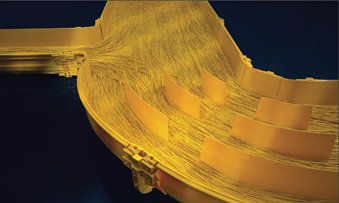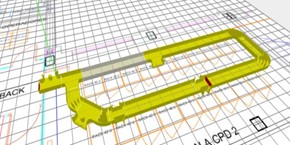Today’s data center networks are experiencing unparalleled growth in fiber deployment. Demands for greater bandwidth, lower latency and unprecedented I/O capacity are ratcheting up the pressure on network managers. In hyperscale data centers and 5G networks, current fiber counts can be as high as 6,912 and even higher-count fibers are being manufactured.[i] As more facilities embrace fiber-rich mesh architectures, the amount of fiber is only going to increase.
Managing the growing density of fibers and cables throughout data centers is becoming a full-time job. If not done well, the ramifications can be severe. Beyond the eyesore of cabling spilling into the aisle, poor fiber management can create a variety of more costly issues. Overfilling cable trays, for example, can restrict air flow between the cables, increasing thermal loading and causing the cooling system to work harder than usually needed. The inability to identify, access and manage individual fibers, compromises meantime-to-resolution, turn-up speed, moves/adds/changes and more. All of this emphasizes the need for a carefully considered cable management strategy.
Growing importance of cable management
Most data centers do, in fact, invest time and resources in developing good cable management strategies. These approaches range from a few basic cable routing guidelines to more thorough and detailed requirements regarding tray capacities, segregating cables by type, fiber labeling, etc.
Another issue that often compounds congestion throughout the data center is the lack of protocols dictating how overhead cable pathways are used. Best practices suggest segregating larger trunk cables from smaller patch cords: ladder racks for large trunk cables, fiber raceways for the patch cords. Likewise, copper and fiber patch cords should have their own pathways.
These management tactics are not only intended to keep the data center’s cable plant accessible and easier to service but can have a significant effect on optical performance as well. A good example is what can happen when large trunk cables are run in raceways designed for smaller patching fibers. As the larger cables exit the raceway via so-called “waterfalls,” it is not uncommon for the cable to exceed the maximum allowable bend radius, affecting optical performance.
In developing a good cable management strategy, no detail is too small. When done right, a cable management strategy not only keeps the current cable plant highly serviceable, it also can provide a template that makes expansion and upgrades to the network faster and more reliable.
The complex world of cable raceway design
Without question, a central component of any cable management system is the network of cabling raceways crisscrossing the data center. These systems are engineered to manage, protect and route thousands of fiber cables. Like the cable management plans that they are a part, cable raceways come in all shapes, sizes and types—metallic, non-metallic and wire mesh; those requiring time and tools for installation and those that are tool-less; short-reach straight runs and extensive networks of cable highways replete with waterfalls and on-ramps. The standards governing their design and use are growing increasingly complex.

Consider this excerpt from an article appearing on the EC&M website:
“When installing optical fiber cables, the requirements for wiring methods are located in Art. 770. Only when Art. 770 references sections in Chapter 2 and Art. 300 do these apply to optical fiber cables and raceways [770.3]. For example, subsection 770.113 refers to 300.22, which applies when installing optical fiber cables and optical fiber raceways in ducts and plenum spaces. Article 770 does not refer to 300.15, so you do not have to put optical splices in boxes. Article 770 also applies to composite cables, which combine optical fibers with current-carrying conductors. You can use these only where the optical fibers and current-carrying electrical conductors are functionally associated [770.133(A)]. Because the NEC considers these electrical cables [770.3(B)], they must comply with the appropriate requirements of Chapter 1 through Chapter 4.”
New raceways and design tools ease complexities
Due to the increasing number of raceway options and growing fiber density in the data center, the most challenging part of implementing a good cable management plan is in the design phase. Fortunately, new design tools incorporating the applicable cabling standards and best practices are helping to make the job much easier and less complex.
CommScope’s FiberGuide® Design Pro, for example, is a configuration tool that enables designers to create 2D- and 3D-layouts in a web-based design tool that provides a clear view of how the raceway will look once installed. Smart build features auto-calculate the number of junctions and supports needed, along with support placement recommendations. Designs can then be exported to create detailed drawings and bills of material for easy ordering and installation. The tool is intended for customers, installers and .
FiberGuide Design Pro is designed to work with the CommScope FiberGuide fiber management system. Designed for flexibility, speed and durability, it’s a comprehensive raceway solution designed to protect and route fiber optic patch cords and multi-fiber cable assemblies to and from fiber splice enclosures, fiber distribution frames and fiber optic terminal devices. As an integrated portfolio, the FiberGuide system consists of modular components—horizontal and vertical runs and elbows, downspouts, junctions, flexible exit kits—and dozens of deployment options. All modules use a secure, snap-in design for tool-less installation. The result is a single raceway system that is easy and fast to deploy, highly flexible and ensures total off-frame protection for the indoor fiber plant.
Strap in and reach out, more fiber to come
If the rate of technology acceleration is any indication of what lies ahead, data centers, especially at the hyperscale cloud level, better strap in. As bandwidth demands and service offerings increase, and latency becomes more critical to the end-user, more fiber will be pushed deeper into the network.
As fiber counts grow, the amount of available space in the data center will continue to shrink. Look for other components, namely servers and cabinets to deliver more in a smaller footprint as well. Space won’t be the only variable to be maximized. Combining new fiber configurations like rollable ribbon fiber cables and 200-micron fiber designs will provide network managers and their installation partners new tools.
Leveraging the benefits of these new designs begins with the basics; that means a well-planned strategy for routing, protecting and managing the inside fiber plant. Projecting future cabling demands and the topologies needed will be critical. So is planning and adapting your cable management infrastructure.
For more information on how CommScope and our FiberGuide platform of raceway solutions and design tools can help you get a handle on your fiber management, click here.
[1] Achieving faster deployment and monetization in hyperscale and Edge data centers; Data Center Dynamics; March 30, 2022













